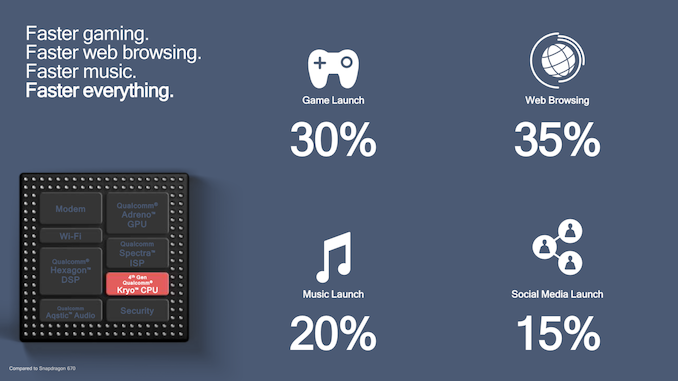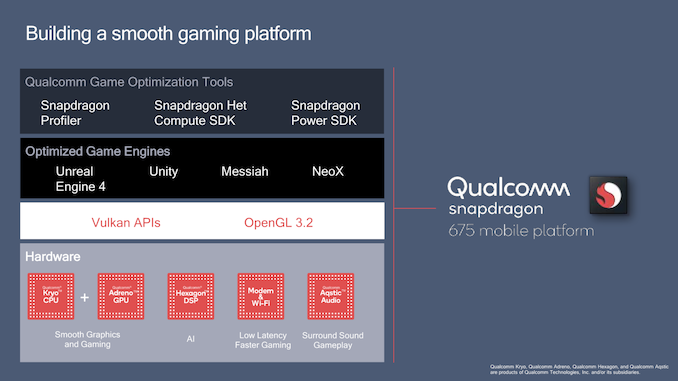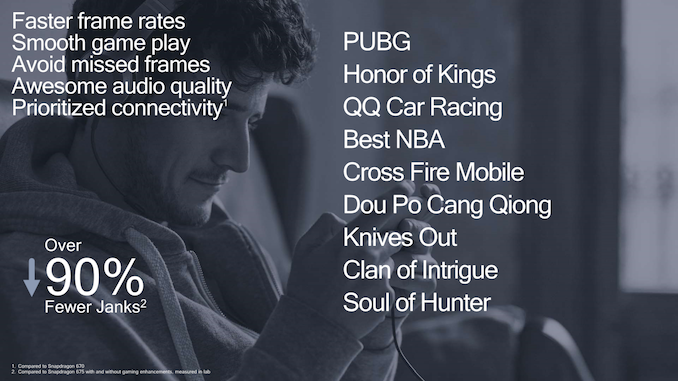Qualcomm Announces Snapdragon 675 - 11nm Mid-Range Cortex A76-Based
by Andrei Frumusanu on October 22, 2018 9:00 PM EST- Posted in
- Smartphones
- Qualcomm
- Mobile
- SoCs
- 11LPP
- Snapdragon 675

Today we’re seeing a very interesting announcement from Qualcomm: The new Snapdragon 675 chipset is a direct successor to the current generation Snapdragon 670 which was only announced back in August. The Snapdragon 675 iterates on the current design, bringing some important upgrades.
| Qualcomm Snapdragon Upper Mid-Range SoCs | |||
| SoC | Snapdragon 670 | Snapdragon 710 | Snapdragon 675 |
| CPU | 2x Kryo 360 (CA75) @ 2.0GHz 6x Kryo 360 (CA55) @ 1.7GHz |
2x Kryo 360 (CA75) @ 2.2GHz 6x Kryo 360 (CA55) @ 1.7GHz |
2x Kryo 460 (CA76) @ 2.0GHz 256KB L2 6x Kryo 460 (CA55) @ 1.7GHz 64KB L2 |
| GPU | Adreno 615 | Adreno 616 | Adreno 612 |
| DSP | Hexagon 685 | ||
| ISP/ Camera |
Spectra 250 ISP 25MP single / 16MP dual |
Spectra 250 ISP 32MP single / 20MP dual |
Spectra 250 ISP triple-camera support |
| Memory | 2x 16-bit @ 1866MHz LPDDR4X 14.9GB/s 1MB system cache |
||
| Integrated Modem | Snapdragon X12 LTE (Category 15/13) DL = 600Mbps 3x20MHz CA, 256-QAM UL = 150Mbps 2x20MHz CA, 64-QAM |
Snapdragon X15 LTE (Category 15/13) DL = 800Mbps 3x20MHz CA, 256-QAM UL = 150Mbps 2x20MHz CA, 64-QAM |
Snapdragon X12 LTE (Category 12/13) DL = 600Mbps 3x20MHz CA, 256-QAM UL = 150Mbps 2x20MHz CA, 64-QAM |
| Encode/ Decode |
2160p30, 1080p120 H.264 & H.265 |
2160p30, 1080p120 H.264 & H.265 |
2160p30, 1080p120 H.264 & H.265 |
| Mfc. Process | 10nm LPP | 11nm LPP | |
The new SoC platform is Qualcomm’s first to employ the newest generation “Kryo 460” CPU microarchitecture. Obviously Qualcomm is still using Arm’s “Built on Arm Cortex Technology” CPU license, meaning the SoC uses a customised order of the Arm IP. What is very exciting to see is that the Snapdragon 675’s Kryo 460 performance CPUs are based on the new Cortex A76 cores. I think this is the first time that a SoC vendor actually introduces a new CPU microarchitecture in a mid-range product first, as I had expected Qualcomm to unveil it in the upcoming Snapdragon flagship.
The performance cores come in a 2x configuration clocking at up to 2GHz, accompanied by 6x Cortex A55 derived efficiency cores, running at up to 1.8GHz.
The CPU performance improvements over the Snapdragon 670’s Cortex A75-based Kryo setup are quoted by Qualcomm to range from 15% in app launches, up to 35% in web browsing scenarios. This roughly matches Arm’s claims of the IPC improvements of the new microarchitecture, and because the Snapdragon 675 is running at the same clock as the Snapdragon 670, the performance improvements are actually due to just the new generation cores.
What also is quite weird is that the new SoC should in effect also outperform the Snapdragon 710 – even though the latter is in a higher tier segment. We’ll likely see a successor to this platform sometime in the future.
As of time of writing, Qualcomm didn’t talk much about raw performance improvements of the GPU. It’s still an Adreno 61x series GPU, and I expect it to be in the performance range of the Adreno 615 or 616.
What Qualcomm did talk about, is that the new SoC employs some sort of software “gaming enhancements” that promise up to 90% fewer janks. Again I followed up with a request with more technical explanation as to what this is, but with no official response as of yet. What is very obvious here is that this sounds strikingly similar to Huawei/Honor’s “GPU Turbo” mechanism in what it promises to achieve. Hopefully we’ll have a more detailed explanation in the future. Similar to GPU Turbo, these gaming enhancements appear to be game title specific.
An improvement on the ISP side is the new support for seamless triple-camera setups. The new Snapdragon 675 adds an additional MIPI CSI port, totalling up to three. This allows the new SoC to be able to operate three cameras at once, which is something that will seemingly become very popular in the comings months as more devices with telephoto, wide-angle, and super-wide angle modules are announced. Here the ISP hardware needs to be capable of enough in terms of throughput to deal with the large amount of pixel data from the sensors.
Qualcomm enables the hardware and software to support both bokeh (portrait modes) and HDR shots in a single shot. Bokeh effects are supported by multiple techniques; either stereo depth sensing via dual cameras, active depth sensing via time-of-flight, or just simply by a single camera sensor which has phase detection pixels.
First Samsung 11nm “11LPP” product?
What surprised me even more than the announcement of a Cortex A76 mid-range SoC, was the revelation that it’s manufactured on Samsung’s new 11LPP manufacturing node. Samsung’s 11nm node is a mix of its 14 and 10nm nodes, and is targeted for cost-effective solutions while still maintaining performance competitiveness with the 10nm products.
Qualcomm didn’t talk much about power efficiency of the Snapdragon 675, and it’s likely that we won’t be seeing any major improvements.
Again it’s remarkable to see Qualcomm having such short product refresh cycles in this range, as seemingly competition is fierce and pricing in the mid-range is a cut-throat business in order to achieve design wins.
The big remaining question is where and when does the Snapdragon 675 position itself against its current counter-parts? The new SoC is scheduled to be available in commercial devices in Q1 of 2019. As Snapdragon 670 devices have already started to launch, the two products will co-exist with each other for some time.
Related Reading
- Qualcomm Reveals The Snapdragon 670 Platform: Dual Big Cores + Adreno 615
- Samsung Details 11LPP Process Technology: 10 nm BEOL Meets 14 nm Elements
- Qualcomm Announces Snapdragon 710 Platform
- Qualcomm Announces Snapdragon 700 Series Platform: Carving Out A Niche for Sub-Premium
- The Snapdragon 845 Performance Preview: Setting the Stage for Flagship Android 2018
- Qualcomm Announces Snapdragon 660 & 630 Mobile Platforms: Better Connectivity, Camera, & Compute at 14nm
















40 Comments
View All Comments
Wardrive86 - Monday, October 22, 2018 - link
If they can get it in a device with 4GB/64GB, Pie, and a 64 bit kernal in Q1 2019 for $300-350 then they will have a winner. Unfortunately that will probably only happen in China, India etc.serendip - Monday, October 22, 2018 - link
A Mi 8 Lite with 6GB/128GB is about $300 and that comes with a 660. No Pie but that's presumably coming soon. I just want Pie, MicroSD, Android One and a 670/675 at $250-300.Roland00Address - Tuesday, October 23, 2018 - link
Android One is more important than any specific Android version for you will get constant Android updates with the Android One program.So Nokia just announced the 6.1 Plus in July and 7.1 in Oct of 2018, which is in these price points that you just requested. These nokia phones uses the Qualcomm 636 (4 cortex a73, 4 cortex a53) so I bet we will see similar phones in a year or so running this new snapdragon 675 with 2 cortex a76 and 6 cortex a55.
It may just not be Q1 2019 but instead a later date.
hanselltc - Wednesday, October 24, 2018 - link
Indeed very tempting, if only did Nokia copy Apple's -- and Oneplus' slider design.hanselltc - Wednesday, October 24, 2018 - link
In China they're slapping 845s and presumably 855 in phones for that price thoughInzamam - Saturday, March 2, 2019 - link
Redmi Note 7 pro....For India ..
nicolaim - Monday, October 22, 2018 - link
I think there's an error somewhere in the Integrated Modem part of the table.lmcd - Monday, October 22, 2018 - link
Midrange chipset with beyond the Cortex A53?I don't see April 1 on my calendar, what gives?
dudedud - Monday, October 22, 2018 - link
Any news on a 625/450 successor?An 8 core A55 for the low end?
We had been on the A53 combo for too long...
CuriosUser - Tuesday, October 23, 2018 - link
This is exactly what I was waiting for8x a55 with >4000 mAh, full HD screen and decent camera